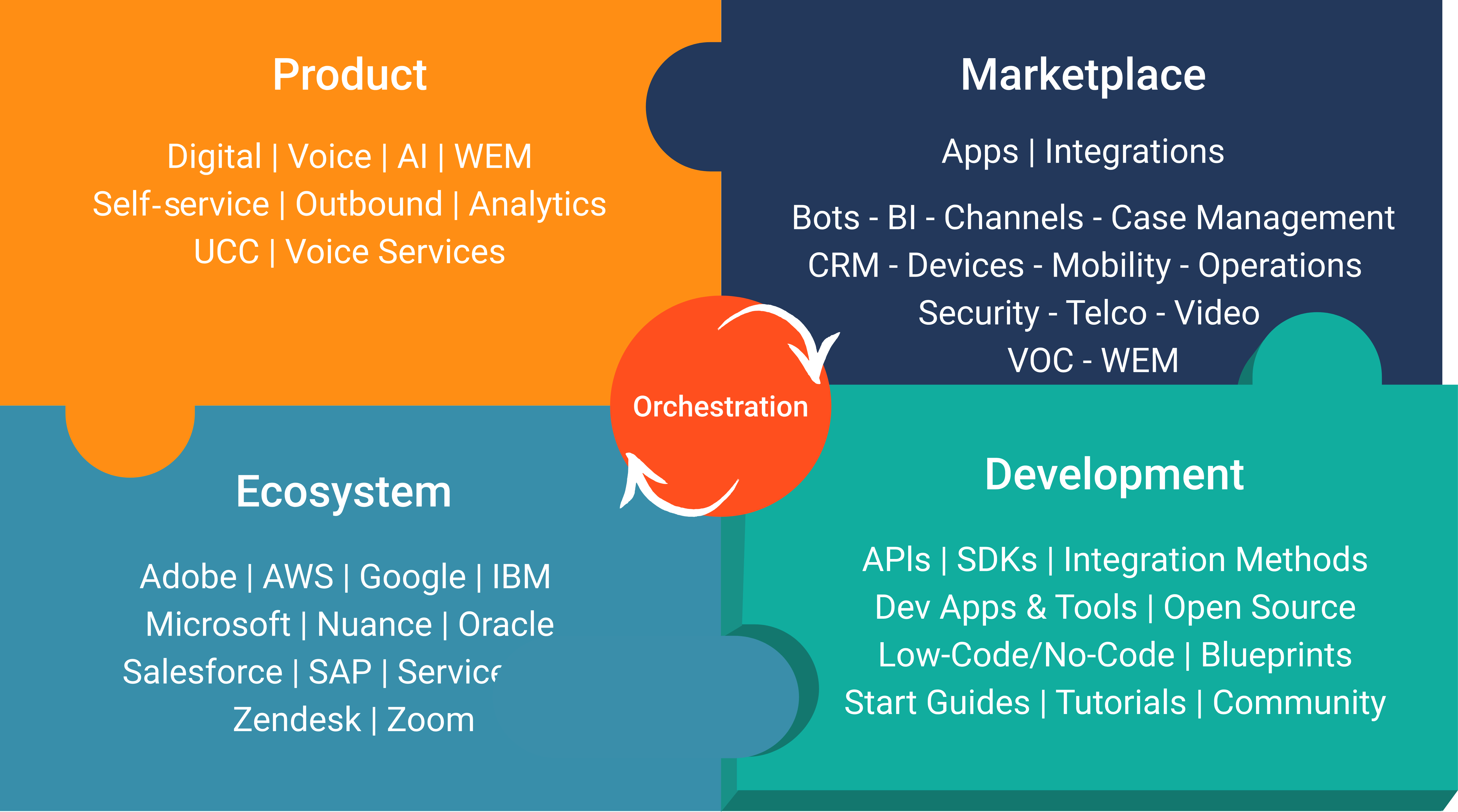Your Genesys Blog Subscription has been confirmed!
Please add genesys@email.genesys.com to your safe sender list to ensure you receive the weekly blog notifications.
Subscribe to our free newsletter and get blog updates in your inbox
Don't Show This Again.

Growth and change in customer preferences are constant. Customers are using digital and voice to connect with businesses more than ever, the preferred social channel changes on a day-to-day basis. And underlying all this is constantly changing and aging technology.
Agility is no longer optional; it’s the key to survival. To compete, you must adapt as customer expectations shift. But that requires more than just a flexible platform. It takes a global marketplace with extensive capabilities you can mix and match, turn on and off, trial, and add or remove to adapt your experiences quickly.
A one-size-fits-all customer or employee experience doesn’t work anymore. Creating and sustaining differentiated experiences requires a real-time, composable platform with an extensive marketplace you can leverage to compose individual components across customer and employee journeys (Figure 1).

But it’s not just about your CX tech stack. CIOs and business leaders at the forefront of customer experience innovation understand that to be a truly composable business, they must organize and execute differently.
In our composable CX blog series, we look at how companies can stop strategizing and building in silos and instead adopt a continuous cocreation mindset. We also look at the four composable CX building blocks powering this shift.
We recently explored why developers should help choose composable CX platforms to turn innovation into a real-time behavior that every layer of the business can adopt. In this article, we outline the three crucial questions you should ask when evaluating CX marketplaces to ensure you can more easily adapt in the face of increasing change and uncertainty.
Question 1. What ecosystem vendor solutions are available in the marketplace?
As Cliff Saran, Managing Editor of Computer Weekly, reported in his article “Data silos and IT complexity stifle business potential,” one in four organizations have more than 50 distinct data silos.
Yikes.
Connecting data, intent and intelligence to drive meaningful outcomes is Job One of a global marketplace. To conquer customer and employee experience goals and KPIs, companies must integrate and use many different tools – CRM solutions, unified communications and collaboration, business intelligence systems, channels, and bots, just to name a few.
Proceed with caution, however. In these fast-moving, chaotic times, many IT teams frantically extend their existing CX suites with various point solutions and coding custom stopgap solutions without any sincere thought into a cohesive CX strategy or the growing technical debt it will cause.
Integration for the sake of integration isn’t wise. To build a composable, agile business, you must be deliberate with how you connect systems and data. Many CX leaders are forming cross-functional, “fusion” teams to ensure goals are aligned across the organization and architecture stays fresh and flowing toward the future.
Question 2. How quickly is the marketplace growing and how easily can I trial and install new applications?
A growing marketplace is a healthy marketplace. A composable platform is always adding new integrations, applications, services, free trials, templates and blueprints to its marketplace catalog —from ecosystem partners and the CX vendor. Consistent marketplace growth shows that the platform and ecosystem partners fully appreciate its value and power. This ensures that, even in the face of increasing change and uncertainty, there will always be turnkey innovation to quickly trial and install.
Speaking of free trials, they are often overlooked in the world of enterprise software. But, in the Forbes article “15 Things Every Business Should Consider Before Buying Enterprise Software,” Pin Chen, CTO at Ontraport, advises, “Before investing in a new software platform, it’s important to know precisely what your strategic goals are and what pain points you are intending to address. If it’s possible to get a free trial, take it. Then, test it out to ensure it meets your expectations and will achieve the goals you laid out for your business.”
Marketplace free trials and quick installs improve the level of agility of a composable CX platform. As these cross-functional, “fusion teams” form to address urgent needs, free trials can help them make time-sensitive decisions without sacrificing due diligence. Make sure your composable CX platform offers marketplace free trials and quick installs, especially for its most popular apps and integrations. And be sure that the number of available free trials is always growing.
Question 3. What other value does the marketplace offer IT and development pros?
Industry-leading marketplaces offer much more than just applications and integrations to accelerate IT and development differentiation. For example, this could include templates to jump start custom solutions or configurations, blueprints with everything-included toolkits and open-source code repositories, or even implementation accelerators from the vendor’s professional services team. Whatever it is, the more pre-built assets IT and development can leverage out of the box, the more they can focus on differentiating innovations and integration customizations.
As Jason Alley of Genesys points out, “By joining the customer experience buying team, [developers] become more aware of packaged product and marketplace capabilities available for purchase — the stuff they don’t have to build. Many assume the dev team already has this information; however, that’s not always the case. Dev teams usually set out to build far more than necessary.”
There’s a direct correlation between the value that the marketplace can offer IT and development pros, and their eagerness to be involved in the cocreation process and mindset. When every layer of the business, including developers, is empowered with the composable capabilities and resources of a global marketplace, enterprise innovation and adaption is turned into a real-time behavior. And that accelerates time to market, improves resiliency and agility, and helps establish the company’s position as a composable business.
In the experience economy, change is the only constant. And that means you can’t afford to sit still. Today’s success won’t matter if you can’t stay a step ahead tomorrow. Agility is the key.
Doing so requires an ecosystem of building blocks that enable you to envision, innovate and deliver customer experiences others have yet to imagine. And then pivot as things change — again.
To adapt at the speed of change, the Genesys AppFoundry® Marketplace allows customers to discover, research, try and buy a broad range of solutions to address changing conditions quickly and easily. You won’t waste time custom-building tools that already exist. AppFoundry solutions are built by trusted partners, customers and Genesys developers. They’re subjected to a thorough review process to ensure quality and security. Any composable CX platform should have the same rigorous standards.
Watch our on-demand webinar to learn how the AppFoundry expands your possibilities with a curated collection of apps, templates and blueprints, so you can experiment, optimize and pivot — no matter how quickly things change.
Subscribe to our free newsletter and get blog updates in your inbox.